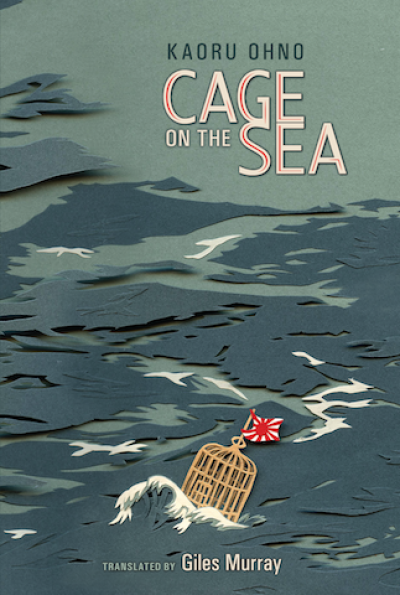Cage on the Sea
Cage on the Sea
By Kaoru Ohno (Translated by Giles Murray)

13 Aug, 2014
0 comments
Note: the Kindle edition of Cage will be going on deep discount on 8/14 (Thurs), the anniversary of the end of WWII. It will start at 80% off ($1.99), then tick up by approximately $2/day until it returns to its normal $9.99 price.
This is a bit outside my usual remit, a strictly historical novel based on events that occurred from 1944 onwards, but it seemed like an interesting choice to inaugurate Translation Wednesdays.
By 1944, the war in the Pacific had developed not necessarily to Japan’s advantage. Logistical challenges were met with increasingly desperate measures, including dragooned cargo ships being sent out without military cover in the hope that if enough ships left port, a few would make it to their destination. Most, of course, did not.
Hyosukemaru, Akebonomaru and Kaihomaru were just three of the many ships that did not arrive at their destinations. Instead, the surviving crew-members ended up on the small volcanic island of Anatahan in the Mariana Islands. The island was not entirely uninhabited (Chammoros have been removed from and returned to the island several times over the centuries according to the whims of various imperial masters) but the surviving sailors were effectively cut off from civilization and news out of the outside world, interpreting what little information they did receive as evidence Japan fought on through out the 1940s and early 1950s1.
In 1944, there were over 30 castways. In June 1951, twenty men remained to surrender. Some of the dead died by accident or misadventure but many died during years of contention centered on the sole woman on the island, Kazuko Higa. Married, although not to the man she was living with on the island, she became the focus of obsession for many of the men trapped on the island, some of whom were more than willing to kill to gain control of her. Kazuko was raped by some of the men and took others as lovers willingly; pretty much all of these men died violently at the hands of jealous rivals.
Matters became worse when a crashed US plane provided three smashed pistols from which two functioning pistols could be made. Control of the pistols offered power but not security; ownership of the pistols was very nearly a death sentence. The rifles and single machine gun the survivors had did not have this effect because the person who controlled them never allowed them to used save for a few instances of target practice. Even in the absence of fire-arms, however, the rivals were quite capable of lethal violence.
Framed by the account of the American who took on the job of trying to convince the rapidly dwindling population of hold-outs on Anatahan that the war was over and they could all return home without shame, the novel covers the years from 1944 to 1951, with a follow-up account of Kazuko’s life after the island, as she managed and mismanaged the fame she got as the notorious “Queen Bee” of Anatahan. Subject of several films, her life off the island was pretty much as miserable as it was on it, high moments followed by long declines; I would like to say the book offers a happy ending but it’s based on real-life events so, no.
I’ve read Hiroo Onoda’s No Surrender: My Thirty-Year War but otherwise post-war Japanese holdouts are not a subject I know particularly well. Ohno’s prose (as translated to English) is very straight-forward but he uses a fairly diverse cast with a fair amount of skill, showing important events from several different perspectives. Often the events are indisputable – this person was shot, that person was stabbed – but the significance remains open to interpretation. The same is true of the characters – what was actually going on in martinet Sergeant Itami’s head is pretty different from how he was perceived and Itami has the advantage of being one of the view-point characters.
The degree to which Kazuko was orchestrating the events around her differs by whose account one reads but it seems reasonable to interpret the whole as a situation where she had very little choice in how men used her body2 and was simply doing whatever she had to do to survive long enough to get off the island.
Not all of the book is focused on Kazuko; the island, which is an active volcano, is a challenging environment in which to survive even when American forces are not supplying it with an unrequested surplus of explosives and bullets. A cut finger can lead to lethal blood poisoning and a poorly chosen meal to fatal dysentery.
Bento Books is a comparatively new company
founded to bring contemporary Japanese fiction to new audiences with an emphasis on titles overlooked by traditional publishers. Japan is a cultural juggernaut, yet the vast majority of its novels and manga remain inaccessible to the English-speaking world. We believe that with an excellent translation, many of these hidden gems could thrive in the West.
Cage on the Sea may be purchased here.
- Part of their misapprehension is that US forces on Saipan disposed of unused munitions by exploding them. The sound was audible 120 km away on Anatahan and was interpreted as an on-going battle for control of the island.
- Not peculiar to her; there’s a subplot with one of the married cast-aways about how frustrating it was for him that his wife was expected to have sex with their boss. That’s presented as unpleasant but not in any way extraordinary.
